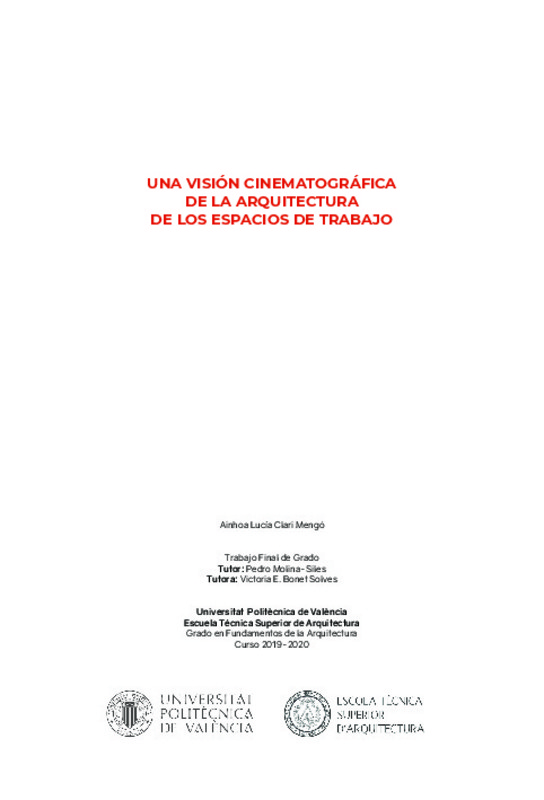JavaScript is disabled for your browser. Some features of this site may not work without it.
Buscar en RiuNet
Listar
Mi cuenta
Estadísticas
Ayuda RiuNet
Admin. UPV
Una visión cinematográfica de la arquitectura de los espacios de trabajo.
Mostrar el registro sencillo del ítem
Ficheros en el ítem
| dc.contributor.advisor | Molina Siles, Pedro Javier
|
es_ES |
| dc.contributor.advisor | Bonet Solves, Victoria Eugenia
|
es_ES |
| dc.contributor.author | Clari Mengó, Ainhoa Lucía
|
es_ES |
| dc.date.accessioned | 2021-10-07T11:50:52Z | |
| dc.date.available | 2021-10-07T11:50:52Z | |
| dc.date.created | 2020-09-18 | |
| dc.date.issued | 2021-10-07 | es_ES |
| dc.identifier.uri | http://hdl.handle.net/10251/174130 | |
| dc.description.abstract | [ES] La oficina es el escenario en el que se desenvuelve, al menos, un tercio de la vida y no siempre es el lugar más adecuado para el desarrollo de una actividad. La abandonamos al salir del trabajo, pero esta nos persigue a través de las pantallas. Espacios arquitectónicos tan reconocibles como la oficina interminable de El Apartamento (The Apartment, Billy Wilder, 1960) o las oficinas corporativas en Playtime (Jacques Tati, 1967), que pueden pasar desapercibidos para muchos, adquieren un gran valor para aquellos que las viven. Como se ve en los casos mencionados, es esta escenografía la que revela aspectos importantes de la historia narrada o información de los protagonistas condicionados tan claramente por el diseño de dichos espacios. El presente trabajo estudia las relaciones existentes entre la arquitectura de los espacios de trabajo y la escenografía cinematográfica. Se centrará en la evolución de las oficinas a lo largo del tiempo y su representación en la gran pantalla. Asímismo el TFG estudia la adaptación de estos espacios a la ficción para determinar si sufren cambios y de qué modo se recurre a esta arquitectura para transmitir sensaciones o influir en ellas. | es_ES |
| dc.description.abstract | [EN] The office is the stage in which at least a third of our life unfolds and it is not always the most suited place for the development of an activity. We abandon it when we get off work, but it haunts us through the screens. Recognizable architectural spaces such as the never-ending office in The Apartment (Billy Wilder, 1960) or the corporative offices in Playtime (Jacques Tati, 1967), that can go unnoticed for many, acquire a great value for those who live them. As we can see in the for mentioned cases, it is this scenery which reveals important aspects of the story or information about the characters/protagonists so clearly conditioned by the designs of said spaces. This work studies the existing relations between the architecture of the workplace and the cinematographic scenery. It focuses on the evolution of the office throughout time and its representation on the big screen. The adaptation of these spaces to fiction will thus be studied to determine if the suffer changes and in which way this architecture is used to convey emotions or influence them. | es_ES |
| dc.format.extent | 103 | es_ES |
| dc.language | Español | es_ES |
| dc.publisher | Universitat Politècnica de València | es_ES |
| dc.rights | Reconocimiento - No comercial (by-nc) | es_ES |
| dc.subject | Arquitectura | es_ES |
| dc.subject | Oficinas | es_ES |
| dc.subject | Cine | es_ES |
| dc.subject | Escenografía | es_ES |
| dc.subject | Architecture | es_ES |
| dc.subject | Offices | es_ES |
| dc.subject | Cinema | es_ES |
| dc.subject | Scenery | es_ES |
| dc.subject.classification | COMPOSICION ARQUITECTONICA | es_ES |
| dc.subject.classification | EXPRESION GRAFICA ARQUITECTONICA | es_ES |
| dc.subject.other | Grado en Fundamentos de la Arquitectura-Grau en Fonaments de l'Arquitectura | es_ES |
| dc.title | Una visión cinematográfica de la arquitectura de los espacios de trabajo. | es_ES |
| dc.type | Proyecto/Trabajo fin de carrera/grado | es_ES |
| dc.rights.accessRights | Abierto | es_ES |
| dc.description.bibliographicCitation | Clari Mengó, AL. (2020). Una visión cinematográfica de la arquitectura de los espacios de trabajo. Universitat Politècnica de València. http://hdl.handle.net/10251/174130 | es_ES |
| dc.description.accrualMethod | TFGM | es_ES |
| dc.relation.pasarela | TFGM\130459 | es_ES |
Este ítem aparece en la(s) siguiente(s) colección(ones)
-
ETSA - Trabajos académicos [4493]
Escuela Técnica Superior de Arquitectura






